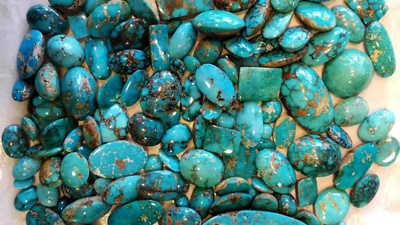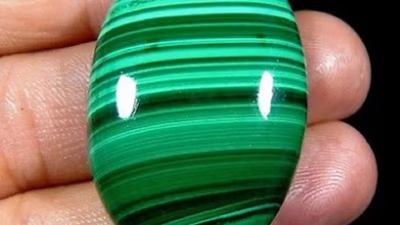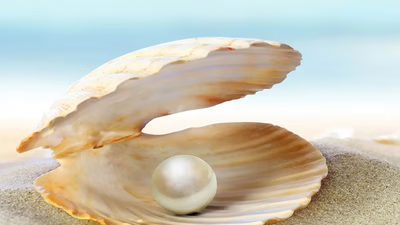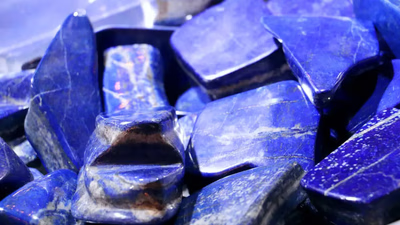
Explore the beauty of turquoise gemstones from the Middle East.
The Middle East, particularly Iran, is known for producing some of the world's finest turquoise gemstones. Afghanistan, located in Central Asia, is renowned for its turquoise production. The country has rich turquoise deposits, and the gemstone has been mined there for centuries. The Nishapur region in northeastern Iran and the adjacent Badakhshan province in Afghanistan share some geological formations and can produce similar qualities of turquoise. Turquoise is also found in smaller quantities in various other countries, including Australia, Chile, Egypt, Israel, Kazakhstan, Peru, and Russia. The quality, color, and characteristics of turquoise from these regions can vary.
The United States has significant turquoise deposits, and it is one of the world's leading producers of the gemstone. Mexico has a long history of turquoise mining, and it is known for its vibrant and high-quality turquoise. The country's most famous turquoise mine is the Cananea mine in Sonora. Other notable mining areas include the states of Durango, Chihuahua, and Zacatecas. China has emerged as a significant producer of turquoise in recent years. The Hubei Province in central China is known for its deposits of turquoise, with the Zhushan mine being one of the most prominent sources.
Iran has a long history of turquoise mining and is renowned for its exceptional turquoise gemstones. The Nishapur region in northeastern Iran is particularly famous for producing some of the finest turquoise in the world. The turquoise from this region is known for its intense blue color and beautiful matrix patterns. The Sinai Peninsula in Egypt is another region in the Middle East known for its turquoise deposits. The turquoise from this area is often referred to as "Sinai turquoise." While not as widely known as Iranian turquoise, Sinai turquoise has its own unique charm and is sought after by collectors and jewelry enthusiasts.
The larger and smoother the turquoise stone, the more valuable it is. This precious stone is often found in cities such as Damghan and Neishabour and can be seen in blue and sometimes pale green or yellow. Ajami and Shajari type of stone is known around the world as Neishabour turquoise stone due to its extraordinary quality and beauty. Ajami turquoise is blue and its shape is round and large. Turquoise type of tree also has streaks that have been formed due to the accumulation of turquoise seeds. The larger the size of the turquoise stone and the smoother its surface, the higher its price. The name of this stone is derived from the French word “Turquoise” meaning Turkish stone.
The smoother and larger the turquoise, the more valuable it is. The color of these gemstones also changes from blue-green to pale yellow. Turquoise is found in Arizona, New Mexico, USA, Australia, Afghanistan, and Iran (Neishabour and Damghan); Neishabour Ajami and Shajari turquoise are very famous not only in the country but also in the world due to its excellent quality; Ajami turquoise is round and coarse and its pure color (garlic blue) is used as the most expensive type of turquoise to make a ring.
Turkey is also known for its turquoise production. The country has various turquoise mines, and the gemstone is often used in traditional Turkish jewelry. The region of Elazig, located in eastern Turkey, is particularly recognized for its turquoise mines. This stone is found in blue and sometimes green and pale yellow color in Iran, which is known as Neishabour turquoise stone in Neishabour due to its extraordinary quality. Ajami turquoise with garlic blue color is round and large and Shajari turquoise has streaks that are composed of a community of several turquoise seeds inside the stone.
-

Amber, formed from ancient tree resin, is predominantly found in Myanmar, particularly in the Hukawng Valley. This fossilized resin, known as Asian amber, dates back approximately 99 million years to the mid-Cretaceous period. Its aesthetic and scientific significance is immense, as it provides insights into ancient ecosystems through the preservation of inclusions like insects and plants. The color variations of Asian amber, including yellow, orange, red, brown, and green, are influenced by tree species and impurities. Highly valued in jewelry, Asian amber is often referred to as the "gold of the sea" due to its beauty and allure. It symbolizes love and tenderness, making it a popular choice for decorative items. However, buyers should be cautious of imitations and treatments that may affect authenticity. Proper care, including storage away from sunlight and gentle cleaning, is essential to maintain its luster. Overall, Asian amber is not only a treasured gemstone but also a vital resource for scientific research, offering a glimpse into the biodiversity of ancient life.
-

Topaz, a gemstone known for its diverse colors, is particularly significant in Asia, with notable varieties including imperial and blue topaz. Imperial topaz, valued for its reddish-orange to pinkish-orange hues, is primarily sourced from Brazil but also found in Myanmar"s Mogok region, renowned for its exceptional quality. Blue topaz, popular for its vibrant hues, is predominantly produced in Thailand and Sri Lanka, where skilled artisans enhance its color through various treatments. Other Asian countries such as India, Pakistan, and Afghanistan also contribute to the topaz market, with India recognized for its large crystal sizes and intricate jewelry designs. Topaz is an aluminum silicate mineral with a hardness of 8 on the Mohs scale, making it suitable for everyday wear. Proper care is essential to maintain its beauty, including protection from harsh chemicals and regular cleaning. The gemstone"s popularity is attributed to its vibrant colors, excellent hardness, and affordability. In addition to its aesthetic appeal, topaz holds cultural significance in Asia, believed to bring good fortune and emotional balance.
The value of topaz is determined by factors such as color, clarity, and size, with imperial topaz commanding higher prices due to its rarity. Overall, Asian topaz gemstones are widely available and used in various jewelry forms, making them a popular choice among consumers.
-

Charoite is a rare and unique gemstone primarily sourced from the Chara River region in Siberia, Russia. Known for its striking purple color and swirling patterns, Charoite is appreciated for its beauty and metaphysical properties, including enhancing intuition and promoting inner strength. Discovered in the 1940s, it gained popularity in the 1970s as a favored choice for jewelry, including rings, pendants, and bracelets. The value of Charoite is influenced by factors such as color, clarity, size, and overall quality, with fine-quality stones commanding higher prices. While it is moderately priced compared to more famous gemstones, its rarity and distinctive appearance make it a sought-after choice for collectors. Charoite is often confused with other gemstones, so it is essential to purchase from reputable sellers to avoid imitations. Proper care is crucial for maintaining its beauty, as Charoite is relatively soft and sensitive to harsh conditions. Cleaning should be done with mild soapy water and a soft cloth. Overall, Charoite"s unique characteristics and spiritual significance contribute to its appeal in both the Asian and global markets."
-

Diamonds hold significant cultural and economic value in the Middle East and Western Asia, symbolizing luxury, wealth, and social status. They are integral to jewelry, particularly in wedding traditions, where diamond engagement rings represent love and commitment. The region showcases a blend of traditional and contemporary diamond designs, with intricate craftsmanship and modern styles coexisting. Major trading hubs, especially Dubai, facilitate diamond commerce, attracting international businesses. The Dubai Diamond Exchange plays a pivotal role in this market, alongside other important cities like Antwerp and Israel. Diamonds are highly valued for their hardness, luster, and rarity, with various colors, including white and blue, being particularly sought after. The mining of diamonds occurs globally, with notable sources in Siberia, Australia, and Botswana. In the Middle East, diamond grading and certification are essential for ensuring quality and authenticity, with institutions like the Gemological Institute of America providing these services. Diamonds are increasingly viewed as investment assets, appreciated for their potential to retain and grow value over time, making them a popular choice among investors in the region.
-

The quality of rubies for jewelry is primarily determined by color, clarity, origin, cut, and size. The most sought-after rubies exhibit a vibrant red hue, particularly the "pigeon"s blood" red, which is characterized by a pure red with a hint of blue. Clarity is also crucial; high-quality rubies have fewer visible inclusions and are often eye-clean. The origin of the ruby can impact its desirability, with Burmese and Mozambican rubies being particularly esteemed. Rubies are known for their hardness, second only to diamonds, and are believed to possess healing properties. The cut of a ruby affects its brilliance and light interaction, with popular shapes including oval, round, and cushion. Size is another factor, as larger, high-quality rubies are rarer and more valuable. Overall, when selecting a ruby for jewelry, one should consider these attributes to ensure the best choice."
-

The Middle East, especially Iran, is a leading source of high-quality turquoise gemstones, with the Nishapur region noted for its intense blue color and unique matrix patterns. Afghanistan"s Badakhshan province also produces notable turquoise, sharing geological similarities with Iran. Other countries contributing to turquoise production include the United States, Mexico, China, and Egypt. The U.S. is a significant producer, with notable deposits in Arizona and New Mexico, while Mexico is recognized for its vibrant turquoise from the Cananea mine. China"s Hubei Province has gained prominence in recent years, particularly the Zhushan mine. The value of turquoise is influenced by size and smoothness, with larger, smoother stones fetching higher prices. The term "turquoise" originates from the French word for "Turkish stone," reflecting historical trade routes.
Variants like Ajami and Shajari turquoise from Neishabour are highly sought after globally. The Sinai Peninsula in Egypt also offers unique turquoise, valued by collectors. Overall, the Middle East remains a pivotal region for turquoise trade, with diverse sources and qualities enriching the global marketplace.
-

Malachite, a copper carbonate hydroxide mineral, is primarily formed through the weathering and oxidation of copper ore deposits. Notable Asian sources include Kazakhstan, Uzbekistan, Russia, China, and Mongolia, known for their unique malachite specimens characterized by vibrant green colors and distinctive banding patterns. Historically valued in various cultures, malachite is associated with protection, healing, and transformation. Its applications range from jewelry to decorative objects, with forms including cabochons and carvings. Malachite"s metaphysical properties are believed to promote emotional healing and balance. Due to its low hardness, it requires careful handling and cleaning with mild soap and water. Authenticity is crucial, as malachite is often imitated. Ethical sourcing is important when acquiring malachite to ensure responsible mining practices. Overall, malachite remains a popular choice for both contemporary and traditional jewelry designs."
-

The Asian apatite gemstone market has seen a rise in popularity due to its vibrant colors and affordability, appealing to a growing middle class. Major sources include Myanmar, India, Sri Lanka, Thailand, and Pakistan, which produce various colors and qualities of apatite. Blue apatite is particularly sought after for its resemblance to more expensive stones like sapphire. The market is influenced by consumer trends favoring unique colors and cuts, with apatite gemstones being used in diverse jewelry forms. Treatments such as heat enhancement are common, necessitating transparency from sellers regarding gemstone modifications. The market operates through physical and online platforms, with trade shows facilitating connections between buyers and sellers. Ethical sourcing and sustainability are increasingly important, as consumers demand responsibly sourced gemstones, pushing market players to adopt fair trade practices and support mining communities.
-

Reputable gemstone retailers, both online and physical, are essential for purchasing authentic agate gemstones. Researching retailers with solid reputations and positive reviews is crucial. Trade shows provide opportunities to connect with dealers and examine gemstones firsthand. Local gemstone stores can also offer guidance from knowledgeable staff. Agate, a semi-transparent stone composed mainly of silica, is popular in jewelry, especially in red, white, and yellow varieties. It is important to consider certified gemstones from reputable laboratories like GIA or AGL for assurance in quality and authenticity. Online marketplaces can be a good option, but caution is advised to ensure vendor verification and buyer protection. Platforms like Etsy and GemRockAuctions are recommended for reliable purchases.
-

Persian Gulf pearls, particularly from Bahrain and the UAE, have a rich history and are highly valued due to their natural formation and cultural significance. Unlike cultured pearls, these organic gems are formed inside oysters in response to irritants, making them rare and desirable. Their unique luster, warm golden hues, and varying shapes contribute to their allure. Larger, round pearls are particularly sought after, while unique shapes like baroque also hold value. The cultural heritage of the region associates pearls with purity and prosperity, enhancing their desirability. The decline of the natural pearl industry due to overfishing and environmental factors has led to increased scarcity, further driving up their market value. Collectors and connoisseurs appreciate the historical context and craftsmanship of antique pearl jewelry, which can appreciate over time. Sustainable practices are being explored to revive the natural pearl industry, potentially impacting future availability. Overall, Persian Gulf pearls remain a symbol of luxury and status, maintaining strong demand in the global market.
-

West Asia"s geological diversity has led to the formation of various gemstones, including turquoise, lapis lazuli, and peridot. The region has a rich history of mining and trading these stones, with ancient civilizations like the Persians and Egyptians utilizing advanced techniques for extraction. Turquoise, particularly from Iran"s Nishapur region, is highly valued, while Afghanistan is known for its lapis lazuli deposits. Peridot has been mined in Egypt for over 3,500 years, and onyx is popular for jewelry and carvings. Coral, though not a traditional gemstone, holds cultural significance in the region. The gemstone industry significantly impacts the economies of Middle Eastern countries, contributing to global trade. Various regions, including Isfahan and Khorasan, are known for their precious stones, which have historically been associated with supernatural beliefs. The Silk Road facilitated the exchange of gemstones, enhancing the diversity and market presence of these valuable minerals. Overall, West Asia remains a vital hub for gemstone trade, with a wide array of stones sought after for their beauty and cultural significance.
-

The value of Afghan emeralds is primarily determined by several key factors: color, clarity, cut, size, origin, and treatment. The most desirable emeralds exhibit a vivid green hue, ideally with slight bluish or yellowish undertones, and should be free from undesirable color zoning. Clarity is also crucial; emeralds with fewer visible inclusions are more valuable, with eye-clean stones commanding higher prices. Additionally, the cut of the emerald influences its brilliance and overall appearance, with well-cut stones maximizing color and minimizing the visibility of inclusions. Size matters, but quality takes precedence; a smaller, high-quality emerald can surpass a larger, inferior one in value. The origin of the emerald, particularly those from the Panjshir Valley in Afghanistan, adds to its desirability and potential premium. Treatments, such as oiling, can affect value, with untreated stones generally being more sought after. Expertise in gemstone evaluation is essential for accurate pricing, and consulting a qualified gemologist is recommended for potential buyers.
-

Chrysocolla is a hydrated copper silicate mineral, typically found in copper deposits, and is known for its vibrant blue, green, and turquoise colors. It is primarily sourced from several Asian countries, including China, Kazakhstan, Uzbekistan, and Russia. The gemstone is formed in the oxidation zones of copper deposits and often occurs alongside other minerals like malachite and azurite. Its porous nature can lead to variations in color and susceptibility to damage, requiring careful handling. Chrysocolla is prized for its aesthetic appeal, often used in jewelry such as pendants and earrings, but its low hardness makes it vulnerable to scratching. The gemstone is sometimes confused with turquoise due to its similar appearance. Beyond its physical properties, chrysocolla is associated with various metaphysical beliefs, including promoting calmness and creativity. Ethical sourcing is crucial when purchasing chrysocolla, as responsible mining practices help ensure sustainability in the gemstone industry.
Additionally, chrysocolla has historical significance in artistic expression, being used in sculptures and decorative objects. High-quality specimens are particularly noted from specific localities, such as the Ray Mine in Arizona and the Peruvian Andes, making them sought after in the market for their unique beauty and vibrant colors.
-

Genuine Lapis Lazuli from Afghanistan is characterized by its deep blue color, often referred to as "royal blue." Authentic stones may contain pyrite inclusions, which are golden flecks that help confirm their origin. The value of Lapis Lazuli increases with the presence of more pyrite and fewer white calcite streaks. This gemstone is primarily composed of lazurite, alongside calcite and sodalite. The Sar-e-Sang deposit in Afghanistan is the original source of Lapis Lazuli, known for its high-quality stones. The texture of authentic Lapis Lazuli is smooth and fine-grained, and it feels dense compared to imitations. Additionally, it may exhibit weak to moderate orange fluorescence under UV light, serving as another authenticity indicator. For those uncertain about their stone"s authenticity, consulting a gemologist or reputable jeweler is advisable, as they possess the expertise to accurately assess the gemstone"s characteristics.
-

West Asian countries, particularly Afghanistan and Pakistan, are leading producers of high-quality morganite gemstones, derived from the beryl mineral. While Iran and Turkey also contribute, their output is lesser. Morganite is cherished for its pastel hues, ranging from light pink to peach, often with a hint of violet due to manganese traces. The region"s natural morganite showcases a spectrum of pink shades, with some exhibiting deeper colors. Its quality varies, with premium stones being clear, well-saturated, and consistent in color. Morganite is increasingly popular in jewelry, especially for engagement rings, due to its romantic appearance and affordability compared to other gemstones. It serves as an attractive alternative to pink sapphires and diamonds. The Middle Eastern market plays a significant role in the global demand for morganite, with trade occurring through local markets, jewelry stores, and online platforms.
Ethical sourcing and responsible mining practices are gaining importance, ensuring that morganite is obtained sustainably while supporting local communities. Proper care is essential for maintaining morganite"s beauty, including protection from harsh chemicals and extreme conditions.
-

Jade holds significant cultural importance across various civilizations, particularly in Asian cultures, symbolizing purity, wisdom, and prosperity. Its rarity and desirability in the jewelry market stem from the limited availability of high-quality jade, especially in larger sizes and vibrant colors like imperial green. This gemstone"s durability, ranking 6 to 7 on the Mohs scale, makes it suitable for everyday jewelry, including rings and pendants. Jade"s versatility in color and design allows for a wide range of creative expressions among jewelry designers. Additionally, jade is believed to possess healing properties and is associated with luck and protection, further enhancing its appeal. The interplay of light and color within jade creates a captivating visual effect, making it a sought-after choice for collectors and enthusiasts. As a result, fine-quality jade can appreciate in value over time, making it an investment-grade gemstone. Its cultural significance, unique appearance, and demand contribute to jade"s enduring importance in the jewelry market."
















